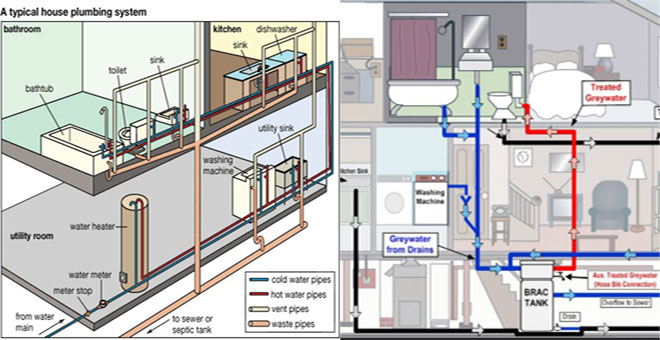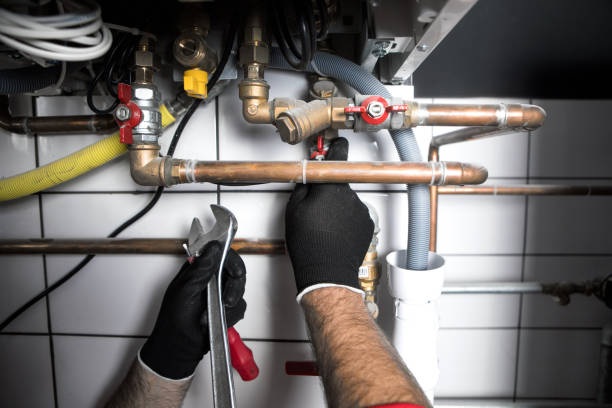What are your thoughts and feelings on Exploring Your Homes Plumbing Anatomy?

Recognizing exactly how your home's plumbing system works is necessary for every property owner. From supplying tidy water for drinking, food preparation, and bathing to safely eliminating wastewater, a properly maintained plumbing system is important for your family members's wellness and comfort. In this extensive overview, we'll explore the elaborate network that comprises your home's pipes and deal suggestions on maintenance, upgrades, and dealing with usual concerns.
Introduction
Your home's pipes system is more than just a network of pipelines; it's an intricate system that ensures you have accessibility to tidy water and reliable wastewater removal. Knowing its elements and exactly how they interact can assist you protect against costly repairs and guarantee whatever runs efficiently.
Standard Elements of a Pipes System
Pipelines and Tubing
At the heart of your plumbing system are the pipes and tubing that carry water throughout your home. These can be made from different products such as copper, PVC, or PEX, each with its benefits in regards to longevity and cost-effectiveness.
Components: Sinks, Toilets, Showers, and so on.
Components like sinks, commodes, showers, and bath tubs are where water is made use of in your house. Recognizing just how these components attach to the pipes system aids in detecting issues and preparing upgrades.
Valves and Shut-off Points
Valves control the flow of water in your plumbing system. Shut-off valves are crucial throughout emergency situations or when you require to make repair services, enabling you to separate parts of the system without interrupting water flow to the entire house.
Supply Of Water System
Key Water Line
The major water line attaches your home to the local water system or a private well. It's where water enters your home and is distributed to various components.
Water Meter and Stress Regulator
The water meter steps your water usage, while a pressure regulatory authority makes sure that water flows at a safe stress throughout your home's pipes system, avoiding damage to pipes and components.
Cold Water vs. Warm water Lines
Comprehending the distinction in between cold water lines, which provide water directly from the primary, and hot water lines, which lug heated water from the hot water heater, helps in repairing and planning for upgrades.
Water drainage System
Drain Pipes and Traps
Drain pipelines carry wastewater far from sinks, showers, and commodes to the drain or septic system. Traps protect against sewage system gases from entering your home and likewise catch debris that can cause blockages.
Ventilation Pipes
Air flow pipes allow air right into the drain system, avoiding suction that can slow down drainage and create catches to empty. Correct air flow is crucial for keeping the integrity of your plumbing system.
Value of Proper Drain
Making sure appropriate water drainage stops back-ups and water damage. Routinely cleaning up drains and preserving traps can protect against costly fixings and extend the life of your pipes system.
Water Heating System
Sorts Of Water Heaters
Hot water heater can be tankless or typical tank-style. Tankless heaters heat water on demand, while containers save heated water for instant usage.
Exactly How Water Heaters Attach to the Plumbing System
Understanding how water heaters link to both the cold water supply and warm water circulation lines helps in identifying problems like not enough hot water or leaks.
Maintenance Tips for Water Heaters
On a regular basis purging your hot water heater to remove debris, examining the temperature settings, and checking for leakages can expand its lifespan and improve energy effectiveness.
Typical Pipes Problems
Leakages and Their Reasons
Leakages can happen as a result of maturing pipelines, loosened fittings, or high water pressure. Dealing with leaks promptly prevents water damage and mold growth.
Clogs and Blockages
Clogs in drains and toilets are typically triggered by flushing non-flushable items or an accumulation of oil and hair. Making use of drain screens and being mindful of what decreases your drains pipes can protect against clogs.
Signs of Plumbing Issues to Look For
Low tide stress, slow-moving drains, foul odors, or unusually high water bills are indications of prospective plumbing problems that should be attended to promptly.
Pipes Upkeep Tips
Regular Evaluations and Checks
Schedule yearly pipes examinations to capture concerns early. Search for indications of leaks, rust, or mineral accumulation in taps and showerheads.
Do It Yourself Maintenance Tasks
Easy tasks like cleaning tap aerators, looking for commode leaks utilizing dye tablet computers, or shielding subjected pipelines in chilly climates can stop major pipes concerns.
When to Call an Expert Plumber
Know when a plumbing issue calls for expert experience. Attempting intricate repairs without appropriate understanding can lead to even more damage and higher repair costs.
Updating Your Plumbing System
Reasons for Upgrading
Updating to water-efficient fixtures or replacing old pipelines can improve water top quality, decrease water bills, and enhance the value of your home.
Modern Pipes Technologies and Their Benefits
Explore modern technologies like smart leakage detectors, water-saving toilets, and energy-efficient hot water heater that can save cash and minimize environmental influence.
Price Considerations and ROI
Determine the upfront prices versus lasting savings when considering pipes upgrades. Lots of upgrades spend for themselves with decreased utility costs and fewer repairs.
Ecological Effect and Conservation
Water-Saving Components and Appliances
Mounting low-flow taps, showerheads, and toilets can dramatically minimize water usage without giving up efficiency.
Tips for Reducing Water Use
Basic habits like dealing with leaks promptly, taking much shorter showers, and running full lots of laundry and meals can preserve water and lower your energy expenses.
Eco-Friendly Plumbing Options
Think about sustainable pipes materials like bamboo for floor covering, which is durable and environment-friendly, or recycled glass for countertops.
Emergency situation Preparedness
Steps to Take Throughout a Plumbing Emergency situation
Know where your shut-off valves lie and exactly how to shut off the water in case of a burst pipe or significant leak.
Relevance of Having Emergency Calls Useful
Maintain contact info for neighborhood plumbings or emergency situation solutions readily offered for quick feedback during a plumbing situation.
DIY Emergency Fixes (When Relevant).
Momentary solutions like making use of duct tape to patch a leaking pipe or putting a container under a dripping faucet can minimize damages till a professional plumbing shows up.
Final thought.
Recognizing the anatomy of your home's pipes system empowers you to maintain it effectively, saving time and money on repair work. By complying with routine maintenance routines and remaining informed regarding contemporary pipes modern technologies, you can guarantee your pipes system operates effectively for many years to find.
HOW YOUR PLUMBING SYSTEM WORKS
Which Pipes Do What?
Blue lines = fresh water supply entering the building
Red lines = hot water supply entering the building
Grey lines = pipes carrying waste away from the building and venting pipes carrying gases away from the building (through the roof)
YOUR MAIN PLUMBING SYSTEMS
There are two main plumbing systems that support your home s basic plumbing needs one that brings clean water into your home, and one that sends dirty water away from your home. Connected to the toilet, bath, shower, and other faucets in your home, these two systems keep your water flowing in the right directions.
ACCESSING FRESH WATER
Fresh and clean water is brought into your home through the main water supply line . Filtered through one pipe, this water is pressured to flow into the various fixtures in your home at any given time.
This water can be sourced from a well located on your property, a pond or river (mostly cottages), or, as in most cases, from the city s municipal water treatment centre. However, it is important to note that water that is untreated, such as the water siphoned from ponds or rivers, may not be safe to drink. Personal water supplies always need to be treated for hardness and contaminants before consumed.
MUNICIPAL WATER SUPPLIES
Improve taste and odour
Remove sediment
Eliminate hardness
Reduce chlorine
COLD WATER SUPPLY VS. HOT WATER SUPPLY
Cold water flows into your home or building through the service line, which then distributes hot or cold water to your fixtures. This line is most commonly run through a central column that runs floor to floor. Hot water runs in short and straight pipes as the longer the pipeline, the more heat that will be lost in the transfer. Having shorter pipes also allows residents to access hot water more quickly.
WASTE WATER SYSTEM
Your wastewater system is divided into two parts pipes that send wastewater away from your home and venting pipes that send sewer gas away from your home. Sewage water travels through pipes that flush the water and waste towards local sewers that are operated and managed by your city or town. Most sewer systems rely on gravity to move the wastewater to where it needs to go.
The further away from your toilet or sink, the larger wastewater pipes become. This allows for waste to be disposed of from various parts of your home or business at once without pipe blockages. The angle and flow of these pipes are also essential for keeping your waste pipes clear of build up.
https://harrisplumbing.ca/how-your-home-plumbing-system-works/

HOW YOUR PLUMBING SYSTEM WORKS
Which Pipes Do What?
YOUR MAIN PLUMBING SYSTEMS
There are two main plumbing systems that support your home s basic plumbing needs one that brings clean water into your home, and one that sends dirty water away from your home. Connected to the toilet, bath, shower, and other faucets in your home, these two systems keep your water flowing in the right directions.
ACCESSING FRESH WATER
Fresh and clean water is brought into your home through the main water supply line . Filtered through one pipe, this water is pressured to flow into the various fixtures in your home at any given time.
This water can be sourced from a well located on your property, a pond or river (mostly cottages), or, as in most cases, from the city s municipal water treatment centre. However, it is important to note that water that is untreated, such as the water siphoned from ponds or rivers, may not be safe to drink. Personal water supplies always need to be treated for hardness and contaminants before consumed.
MUNICIPAL WATER SUPPLIES
COLD WATER SUPPLY VS. HOT WATER SUPPLY
Cold water flows into your home or building through the service line, which then distributes hot or cold water to your fixtures. This line is most commonly run through a central column that runs floor to floor. Hot water runs in short and straight pipes as the longer the pipeline, the more heat that will be lost in the transfer. Having shorter pipes also allows residents to access hot water more quickly.
WASTE WATER SYSTEM
Your wastewater system is divided into two parts pipes that send wastewater away from your home and venting pipes that send sewer gas away from your home. Sewage water travels through pipes that flush the water and waste towards local sewers that are operated and managed by your city or town. Most sewer systems rely on gravity to move the wastewater to where it needs to go.
The further away from your toilet or sink, the larger wastewater pipes become. This allows for waste to be disposed of from various parts of your home or business at once without pipe blockages. The angle and flow of these pipes are also essential for keeping your waste pipes clear of build up.
https://harrisplumbing.ca/how-your-home-plumbing-system-works/
We had been brought to that report on Exploring Your Homes Plumbing Anatomy from an acquaintance on a different blog. Remember to take a moment to distribute this write-up if you appreciated it. Bless you for being here. Come back soon.
Schedule Your Service